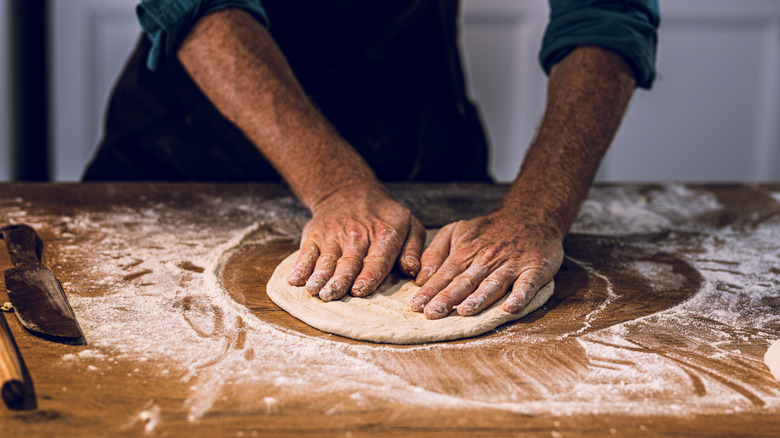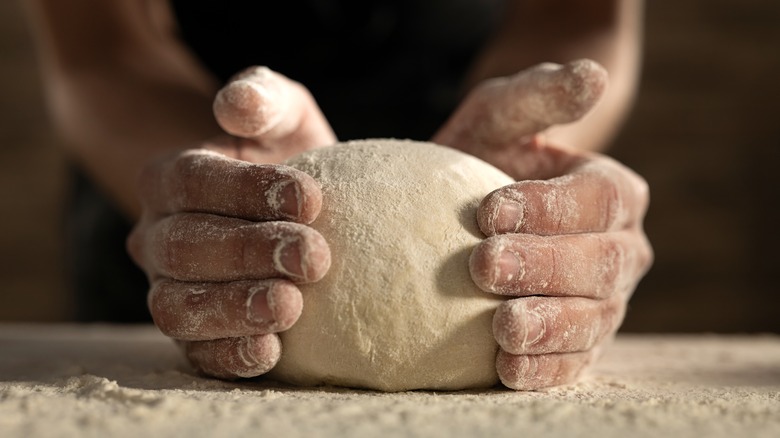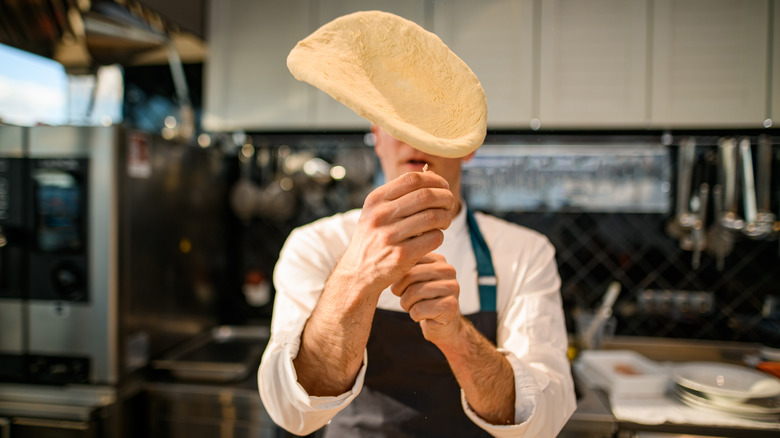Why It's A Mistake To Use A Rolling Pin On Pizza Dough
If you're an enthusiastic home baker, the phrase "dough work" probably takes your mind straight to a rolling pin. And that's totally understandable — it's the go-to tool for shaping dough, whether you're making pasta or pie crust. However, if you're spinning up a pizza, it's best to keep that rolling pin far away from your kneading station.
The key to a great homemade pizza crust is achieving a "rubbery" and smooth texture in the dough. When you poke it, there shouldn't be any holes; instead, it should bounce right back. But getting there requires some serious elbow grease. Ask any pizza maker (or pizzaiolo), and they'll tell you: It takes up to 12 minutes of hand-kneading to reach the perfect level of firmness without any sagging (a stand mixer will be faster, needing as little as 8-10 minutes.)
Once the dough ball is formed and it's time to transform it into the classic disc-shaped dough base, experienced pizzaiolos might throw the pizza dough into the air, letting gravity do the work stretching out the dough, but that takes a lot of skill and practice. This is where many at-home pizza makers will be tempted to reach for their rolling pin to flatten out the dough. However, that's a big no-no. The soft, pliable dough you've just kneaded will toughen up immediately if you try to roll it out, ruining the texture of your pizza crust!
The science of kneading pizza dough
When you knead a ball of dough, some fascinating science will unfold within it at the microscopic level. Wheat flour, typically used in pizza dough, contains two proteins: Gliadin and glutenin, which make up gluten. Fresh out of the mixer, these proteins are scattered all over the place, resulting in a dough that lacks structure and tends to sag.
However, as you knead the dough, these proteins start to come together while a sturdy and orderly binding matrix forms. The longer you knead, the stronger this becomes, transforming the dough from a stretchy mess into a firm, cohesive ball.
The gluten structure also plays a crucial role in the dough's rise. It acts as a trap for the carbon dioxide gas released by the yeast living within the dough. As the dough rests, this trapped gas causes it to expand, turning it into a kind of balloon filled with thousands of tiny air pockets. You can witness this structure firsthand when you slice through a risen dough ball — there should be heaps of tiny air chambers within the core of the dough!
A rolling pin will squish the bubbles out of the dough
To say that these air bubbles are precious would be an understatement. They're crucial for creating a tender, chewy pizza crust. Without them, your dough would end up tough, and your pizza would taste like cardboard. So, once you've finished kneading, your top priority is to stretch the dough without destroying those precious bubbles inside.
That's why pizza makers toss and spin their dough in the air. This method allows the dough to flatten into a disc without the need to press fingers into it and ruin the internal structure. If you're not comfortable with this technique, using a rolling pin is the last thing you should do. Rolling over the dough will burst the air bubbles and literally deflate all the hard work you put into kneading for the past several minutes!
Instead, opt for a simpler approach. Gently tug and stretch one edge of the dough ball toward the corner. It might take longer than the spinning trick, and the final disc might not be as perfectly round or neat as one made by a professional pizza maker. But it will still taste far better than a dry, tough crust. Plus, some people will appreciate the homemade charm of the slightly uneven pizza base.


